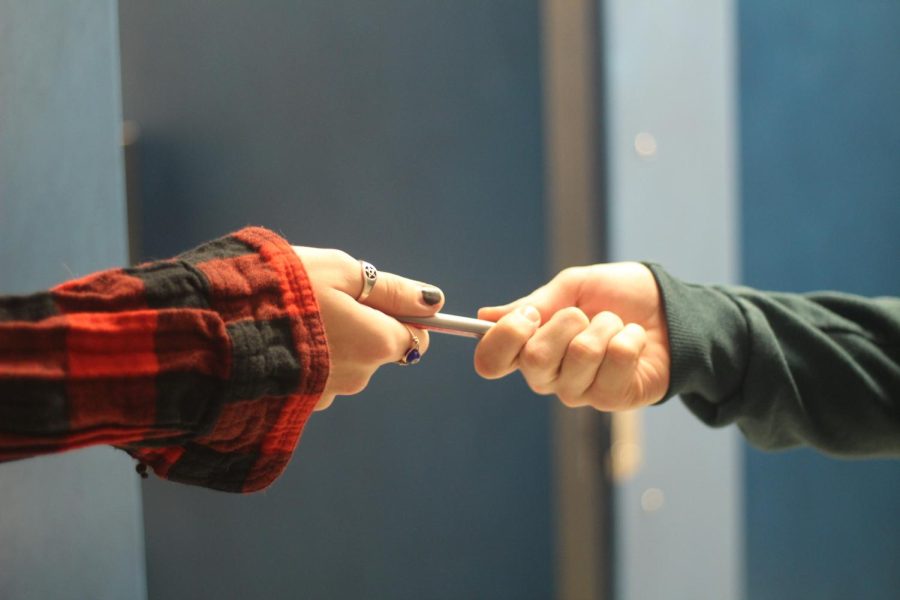The lows of getting high: exploring the effects of smoking on students
Credit: Hannah Locke
Photo illustration
February 13, 2023
Smoke clouds drift above stall walls – a constant haze of marijuana scent and smoke in the air. Welcome to the bathrooms of Loy Norrix.
The continuous issue of smoking in bathrooms has been on Norrix’s priority list for many years now. The popularization of marijuana vape cartridges in 2016 started an epidemic in high schools across the nation, allowing students to bring their substances into school discreetly and with ease. Prior to the introduction of these devices, marijuana use at Loy Norrix was a much less pressing issue.
“It’s one of those things that’s gotten to be an issue very quickly, so I think we’re still trying to process what our steps should be,” said Norrix history teacher Matthew Porco who has been teaching history at the school for 24 years.
Many students have been taking advantage of the convenience of these cartridges and use them on a frequent basis to fuel their addictions in school bathrooms. Most often, these marijuana cartridges are small pen-shaped devices that fit into almost any pants or jacket pocket, or slip right into a backpack. Filled with cannabis oil, solvents and other flavoring solutions, these small cartridges only need a small battery to heat the coil that burns the oil and allow people to inhale THC more discreetly than smoking.
“I take the hall pass at least once or twice each class, and then in between classes,” said a Loy Norrix senior in reference to his marijuana usage in school. “I only had three classes right, so I would always take a hall pass once, maybe twice a class, so that’s six hits, and then in between classes, that’s six more hits. So overall, about 12 hits per day,” said a LN student.
Other issues such as vandalism, lack of security, and an overall unsafe environment have coincided with the issue of smoking in many bathrooms and have led to frequent bathroom closures, which bring up even more issues.
Unfortunately, bathroom closures corral many of the students who smoke and clusters them into the limited number of bathrooms that are open. This makes it more difficult for their non-smoking peers to use the bathrooms. Then the bathrooms become clogged with extra people, and it creates a negative environment in general.
It can be very uncomfortable for some students who are just going in there to do their business, and student smokers consistently get in the way.
“It’s just kind of an annoyance, but what really bothers me is when people [the students who smoke] are standing in front of the sinks, or like lying on the floor. Just like why are you even here? It’s just disgusting,” said senior Kelcey Briggs.
Many of these student smokers are aware of the issue as well. But despite this, those students shared the opinion of one senior smoker who said, “I care, but I don’t care enough.”
Although this issue gets a lot of attention from the administration, they struggle to control the situation due to the lack of resources and staff. Against popular belief, the girls’ bathrooms are causing the most trouble. The lack of staff, specifically female security guards, makes it very difficult to regulate female students who are smoking.
“Our male staff does a great job walking in periodically and checking. We now have fewer male students getting caught smoking / vaping in the bathrooms because of that. Now our issue mainly is with the female students because we do not have the female staff to patrol those bathrooms like that,” said assistant principal Andrew Muysunberg.
Despite the fact that there are more male campus safety officers, many male students don’t fear the repercussions of their actions with the increased risk. It is more common for these young men to fear their parents rather than consequences from Norrix staff.
Another LN student said, “It’s just more consequences from my mom,” in reference to being scared of repercussions given for being caught smoking.
On the other hand though, the consequences given by the school are no joke. Students can be suspended for 10 days or even face expulsion. Consequences do, however, vary based on the situation and the student. In some cases, students may have a disability or it is their first time offense. These students will have much different consequences than someone who is a repeat offender.
Head Principal, Chris Aguinaga said, “Punishments can vary anywhere from, if they are a first time offender I would say probably 3 days of suspension. If it’s a multiple time offender, we would be possibly taking them to an expulsion or exclusion hearing, which are days that are beyond 10 days.”
In addition to the consequences for being caught, these students who decide to smoke throughout school can see additional consequences in their grades. Other studies from the National Institute of Drug Abuse say that marijuana usage has many negative effects on students and teens. These academic effects of long-term marijuana use included weakened memory, lower attention span, and an overall decrease in learning ability.
Another study conducted by the National Institute of Drug Abuse looked into the effects marijuana usage had on college students’ GPA. Similar to most other studies, it was found that the people who smoked marijuana on a regular basis, on average, have a lower GPA than those who didn’t. It was also found that many people who frequently smoke marijuana would have a correlating number of absences.
In contrast to these studies, there were mixed emotions about the effects of marijuana on Norrix students.
“It really depends what it is, sometimes it will make me more focused and sometimes it just makes me more stressed,” said a LN senior about his marijuana usage.
Perhaps unsurprisingly, academics are generally not the primary motivation for marijuana use in school or out of it for that matter. For many teens, marijuana represents an escape from the realities of daily life. Quite often, this can bleed into self-medication: students dealing with otherwise undiagnosed mental health issues by using marijuana.
According to the U.S. Department of Justice, teens with depression are twice as likely to use marijuana or other substances, in an attempt to combat the symptoms of their depression.
Studies have also been conducted to examine the long- term effects marijuana usage has on mental health issues such as depression and anxiety. So far, the results have been mixed.
In a study by the University of Washington’s Alcohol and Drug Abuse Institute, researchers found that at lower doses THC, the active hallucinogen in marijuana, can reduce symptoms of anxiety. They also found that in higher amounts, THC can increase those same symptoms.
“Being in school can be a really awkward environment when I’m too high. Especially when I have to socialize or maybe participate a little bit more in what we are doing in class. That can definitely cause some stress,” said a LN senior.
Long-term effects on adolescents and teens is also a major concern. It is heavily advised that people under the age of 25 should not use the substance of marijuana because of the effects it has on the developing brain. Commonly these are seen as a decline in memory, worsened attention span and just an overall disconnect in cognitive ability. With a lack of research and long-term studies, it is hard to say if the effects of marijuana leave any permanent effects on the brain physically.
Despite the fact that there are limited long-term studies, the National Institute of Drug Abuse said, “Recent research suggests that smoking high-potency marijuana every day could increase the chances of developing psychosis by nearly five times compared to people who have never used marijuana.”
From an objective standpoint, it seems the cons heavily outweigh any pros when it comes to using marijuana in school. However, this clearly has little to no effect on many student’s opinions or their actions. The current system for dealing with the issue seems to have a similarly insignificant effect on student’s habits. It now falls to the administration to tailor a solution to better fit this new generation of Loy Norrix students.















